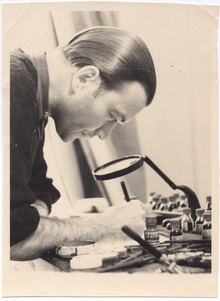Hainer Hill
Hainer Hill | |
|---|---|
 Hainer Hill at work, c. 1956 | |
| Born | Heinrich Hill 28 July 1913 |
| Died | 20 August 2001 (aged 88) Karlsruhe, Germany |
| Education | Städel'sche Kunstschule |
| Occupations |
|
| Organizations | |
Hainer Hill (born Heinrich Hill; 28 July 1913 – 20 August 2001) was a German scenic designer, costume designer, painter, graphic artist and theatre photographer who was based in Berlin and worked internationally. After studying painting in Frankfurt, he worked at the
Life and work
1913–1945
Born in
1945–1961
After World War II, Hill worked as scenic designer at the Städtische Bühnen Gera and then at the
1961–2001
The building of the
Hill died on 20 August 2001 in Karlsruhe. His gravestone shows his motto: "Die Seele des Bühnenraums ist das Licht. Es gibt der Phantasie des Betrachters die notwendige Orientierung" ("The lighting is the soul of the stage. From it, the imagination of the audience gets the orientation it needs".) His estate is held at three locations, by Deutsches Theatermuseum, in the Generallandesarchiv Karlsruhe, and in the Bertolt-Brecht-Archiv der Akademie der Künste, especially his photographs of Brecht's performances with the Berliner Ensemble.[3]
Further reading
- Die Gewehre der Frau Carrar: Mit 22 Fotos aus der Aufführung des Berliner Ensemble (in German), Berlin: Aufbau-Verlag, 1961
- Käthe Flamm (1974), Kulturamt der Stadt Dortmund (ed.), "Hainer Hill, der Bühnenbildner", Hier. Dortmunder Kulturarbeit. Rückblick (in German), no. 31 oder 32, Dortmund: Wulff & Co., pp. 22–25
- Ingvelde Geleng (1974), Kulturamt der Stadt Dortmund (ed.), "Meister der Projektion. Hainer Hills Beitrag zum zeitgenössischen Bühnenbild", Hier. Dortmunder Kulturarbeit. Rückblick (in German), no. 31 oder 32, Dortmund: Wulff & Co., pp. 26–28
- Lothar Schirmer, Dirk Praller (2005), Thomas Lindemann (ed.), Bühnen-Bilder. Hainer Hill und die Kunst der Projektion, Lindemanns Bibliothek 26 (in German), Karlsruhe: Info Verlag, ISBN 3-88190-415-8
- Lothar Schirmer (1998), Museumspädagogischer Dienst Berlin (ed.), "Bertolt Brecht und Caspar Neher", Museumsjournal. Berichte aus Museen, Schlössern und Sammlungen in Berlin und Potsdam, Berliner Museen (in German), vol. 6. Folge, no. I, Berlin, pp. 35–36, ISSN 0933-0593
References
- ^ ISBN 978-3-32-283300-6.
- ^ a b c d e f g h i j k Schirmer, Lothar; Praller, Dirk (2005). Lindemann, Thomas (ed.). Bühnen-Bilder. Hainer Hill und die Kunst der Projektion. Lindemanns Bibliothek 26 (in German). Karlsruhe: Info Verlag.
- ^ Akademie der Künste. 2014. Retrieved 8 August 2002.
- ^ Thomas, Annette, ed. (February 2019). "Landesarchiv Berlin C Rep. 167 / Deutsche Staatsoper" (PDF). content.landesarchiv-berlin.de (in German). Retrieved 25 July 2020.
- ^ "Hainer Hill". archiviostorico.operaroma.it (in Italian). Retrieved 8 August 2020.
- ^ "Lohengrin". Royal Opera House. Retrieved 8 August 2020.
- ^ "Mathis der Maler / Performances". Schott Music. Retrieved 4 September 2020.
- ^ Steffens, Walter. "Werke / Works". walter-steffens.de. Retrieved 8 August 2020.
External links
- Literature by and about Hainer Hill in the German National Library catalogue
- Hainer-Hill-Archiv in Archiv der Akademie der Künste
- Nachlass Hainer Hill (1913-2001): Korrespondenz, Fotos, Zeichnungen (Bestand) (in German) deutsche-digitale-bibliothek.de
- Hainer Hill: Bühnenbilder: 22.9 - 3.11.72 ; Entwürfe, Skizzen, Figurinen, Modelle, Fotos ; Ausstellung im Theater d. Stadt Marl (catalogue, in German)
